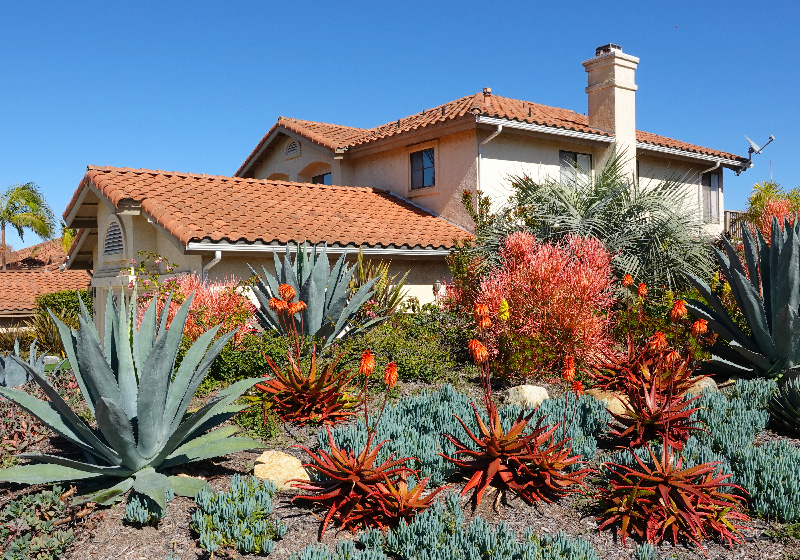The classic American home is most often imagined as a nice colonial or Cape Cod house with a white picket fence and a pristine, freshly-cut lawn, all lined up in a cul-de-sac filled with homes taken care of with the exact same attention to detail. There are many aspects of the modern home that are tough to divorce from that classic picture, but despite this fact, one modern movement is attempting to hit the reset button on what a lawn should be.
The so-called, “Anti-Lawn Movement” advocates for the removal of a traditional all-grass, low diversity lawn in favor of a more natural option instead. Rather than the uniform, finely-trimmed grass and hedgerow, this means wildflowers, clovers, and a landscape that matches the local region. For many, the results of the Anti-Lawn Movement may feel like an untidy excuse to cut down on regular maintenance, but there may be plenty of other benefits that come with this type of seismic change!
To get a better idea of why someone would want to move away from their grass lawns, let’s discuss where today’s lawn came from in the first place and why a change may be in store.
Where Did the American Lawn Come From?
Believe it or not, the modern lawn hasn’t always existed in its current form! Most commonly traced back to northern Europe, farmers needed large stretches of land so that their livestock could graze and feed freely. Grass and livestock are believed to have developed alongside one another, and the first “yards” may have been differentiated by the raised walls (called, “ha-has”) used to keep animals away from homes.
When Europeans settled the region, they brought livestock that were accustomed to a specific kind of grass diet not native to North America. To feed their livestock, settlers brought old world grass to the Americas. The “new norm” stuck: the rise of the suburbs led to widespread standardizing of homes, which sees the American lawn in its current state.
Today, the prevalent style is a large lawn full of non-native grass that requires intensive care. Turns out, it’s a largely American and Canadian thing–you won’t find this type of lawn in most other places. This is just one reason why many are calling for the perfectly manicured non-native grass lawn to be put to rest.
What’s the Problem with the Modern Lawn?
Today, keeping up with the ongoing maintenance of a lawn can be a demanding process. Homeowners need to water, mow, pull weeds, and use pesticides to ward off unwanted insects and animals, all in an effort to get their lawns looking green and healthy. The problem? For one, the modern home uses–and wastes–a lot of water.
According to the Environmental Protection Agency, the average home uses 320 gallons per day. Out of all of a residential property’s water usage, around one-third is used outdoors, and about half of that water is completely wasted due to inefficient watering systems. The grass seeded in lawns all across the U.S. and Canada need a lot of water to thrive, but that’s only one facet of their needs. Their pesticide demands also limit the natural habitat for wildlife and room for natural plants that insects like honey bees and butterflies look for.
The current state of the lawn might demand too much, after taking a step back to consider the full picture. But is there a realistic answer?
Enter the Anti Lawn Movement
The Anti-Lawn Movement might feel like a stretch for traditionalists, and homeowners that have invested into their classic lawn look aren’t likely to appreciate their neighbors jumping onto the bandwagon. But a new style of lawn is catching on in some regions – and for good reason! In the Southwest (namely, southern California, Nevada, and Arizona), “xeriscaping,” or the use of drought-resistant, native plants, and rocks (per National Geographic) has made cutting down on limited water sources a possibility, while cutting down on maintenance demands at the same time.
Elsewhere, advocates of the Anti-Lawn Movement point towards the natural beauty that native foliage, wildflowers, and trees provide to a home as reason enough to jump onto the bandwagon. Of note, although “rewilding” your garden can lead to savings on water and maintenance time down the road, there are a few considerations to keep in mind before pulling the trigger.
A fully implemented “anti-lawn” involves a ton of initial investment, including letting your existing grass die or digging up your entire lawn before replacing it with something like native clover. With any larger change, homeowners should always check with their local HOA or their municipality for any guidelines or regulations that might limit what they can and can’t do. It may also be wise to check in with the neighbors before implementing unwanted changes.
Planting new trees in your yard may be a great idea as well, but it’s important to give them space to grow and to leave room for your home to remain undamaged. Remember: tree roots can grow deep and seek out water. Roots can even break into sewer lines or damage a home’s foundation if planted too close. As a rule of thumb, take a tree’s projected height, and divide that by two to determine how far away to plant your tree from any structures on the property. Trees provide shade and enrich the habitat of your land – so be sure to take good care of them!
The “anti-lawn” just might be the new standard for homes! If you’re purchasing a new home and thinking of making a change, make sure to consult an NPI inspector first. Did you know the wrong drainage and grading plan can set any landscaping plan in the wrong direction? To make an informed purchase, call NPI before you buy!



